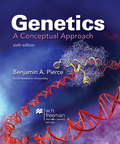
To determine:
The difference in the phenotype of albinism among Hopi Native Americans and other types of albinism and the mutated gene resulting in those
Introduction:
Albinism is a congenital disorder, which results because of the defect in enzymes required for melanin production. Melanin is the pigment that provides dark color to hair, eyes, and skin. Melanin is either not present or produced in little amounts in albino people. It protects skin from skin cancer and dark color of skin prevents DNA (deoxyribonucleic acid) from getting damage because of ultraviolet radiation.
Explanation of Solution
In Hopis, the type of albinism is oculocutaneous albinism which affects skin and eyes only. This type of albinism is caused because of defect in
OCA type II has differential phenotypes. With age, the hair of affected person might turn darker and pigmented freckles or nevi can be observed. The color of irides may be hazel or blue-gray in color in African American and African population. Brown OCA is one of the phenotypic variant. In them, the irides and hair turn darker with age and skin might develop tanning. In all the types of albinism, ocular features are common.
The tyrosinase-positive albinism is characterized by pigment nevi. In African population, the hair color is yellow and there are several pigmented spots in the skin. This kind of albinism develops because of blockage in formation of eumelanin. There are two different phenotypes in tyrosinase-positive albinism, namely- with pigmented patches and without pigmented patches. The individuals having
The individual suffering from ocular albinism may show photophobia, congenital nystagmus, translucent irides, impaired vision, strabismus, and hyperplasia of fovea.
In X-linked albinism, the heterozygous daughter did not have mosaic pattern in ocular fundus. Brown oculocutaneous albinism is linked to P locus. At this locus, OCA2 mutations are located.
Oculocutaneous albinism IA is characterized by absent or decreased melanin pigmentation in eyes, hair, and skin. The optic changes include nystagmus, misignaling of optic nerve, and decreased visual acuity. This is caused by mutation in Tyrosinase gene and is also known as tyrosinase negative OCA.
OCAIII is also known as rufous oculocutaneous albinism. In African population, it is characterized by dilution of color of iris, bright copper coloration of hair and skin. It is caused by mutation in
In OCAIV, the hair color varies between yellow to brown, patients might have nystagmus and color of iris is from blue to brown. This is caused by mutation in
OCAVI is caused by mutation in
OCAVII is caused by mutation in
There are various types of albinism, such as type IA, IB, II, III, IV, V, VI, BCOA, and VII. The types of albinism have differences in the phenotypes of the individuals.
Want to see more full solutions like this?
Chapter 1 Solutions
Genetics: A Conceptual Approach
- Describe the principle of homeostasis.arrow_forwardExplain how the hormones of the glands listed below travel around the body to target organs and tissues : Pituitary gland Hypothalamus Thyroid Parathyroid Adrenal Pineal Pancreas(islets of langerhans) Gonads (testes and ovaries) Placentaarrow_forwardWhat are the functions of the hormones produced in the glands listed below: Pituitary gland Hypothalamus Thyroid Parathyroid Adrenal Pineal Pancreas(islets of langerhans) Gonads (testes and ovaries) Placentaarrow_forward
- Describe the hormones produced in the glands listed below: Pituitary gland Hypothalamus Thyroid Parathyroid Adrenal Pineal Pancreas(islets of langerhans) Gonads (testes and ovaries) Placentaarrow_forwardPlease help me calculate drug dosage from the following information: Patient weight: 35 pounds, so 15.9 kilograms (got this by dividing 35 pounds by 2.2 kilograms) Drug dose: 0.05mg/kg Drug concentration: 2mg/mLarrow_forwardA 25-year-old woman presents to the emergency department with a 2-day history of fever, chills, severe headache, and confusion. She recently returned from a trip to sub-Saharan Africa, where she did not take malaria prophylaxis. On examination, she is febrile (39.8°C/103.6°F) and hypotensive. Laboratory studies reveal hemoglobin of 8.0 g/dL, platelet count of 50,000/μL, and evidence of hemoglobinuria. A peripheral blood smear shows ring forms and banana-shaped gametocytes. Which of the following Plasmodium species is most likely responsible for her severe symptoms? A. Plasmodium vivax B. Plasmodium ovale C. Plasmodium malariae D. Plasmodium falciparumarrow_forward
- please fill in missing parts , thank youarrow_forwardplease draw in the answers, thank youarrow_forwarda. On this first grid, assume that the DNA and RNA templates are read left to right. DNA DNA mRNA codon tRNA anticodon polypeptide _strand strand C с A T G A U G C A TRP b. Now do this AGAIN assuming that the DNA and RNA templates are read right to left. DNA DNA strand strand C mRNA codon tRNA anticodon polypeptide 0 A T G A U G с A TRParrow_forward
 Human Anatomy & Physiology (11th Edition)BiologyISBN:9780134580999Author:Elaine N. Marieb, Katja N. HoehnPublisher:PEARSON
Human Anatomy & Physiology (11th Edition)BiologyISBN:9780134580999Author:Elaine N. Marieb, Katja N. HoehnPublisher:PEARSON Biology 2eBiologyISBN:9781947172517Author:Matthew Douglas, Jung Choi, Mary Ann ClarkPublisher:OpenStax
Biology 2eBiologyISBN:9781947172517Author:Matthew Douglas, Jung Choi, Mary Ann ClarkPublisher:OpenStax Anatomy & PhysiologyBiologyISBN:9781259398629Author:McKinley, Michael P., O'loughlin, Valerie Dean, Bidle, Theresa StouterPublisher:Mcgraw Hill Education,
Anatomy & PhysiologyBiologyISBN:9781259398629Author:McKinley, Michael P., O'loughlin, Valerie Dean, Bidle, Theresa StouterPublisher:Mcgraw Hill Education, Molecular Biology of the Cell (Sixth Edition)BiologyISBN:9780815344322Author:Bruce Alberts, Alexander D. Johnson, Julian Lewis, David Morgan, Martin Raff, Keith Roberts, Peter WalterPublisher:W. W. Norton & Company
Molecular Biology of the Cell (Sixth Edition)BiologyISBN:9780815344322Author:Bruce Alberts, Alexander D. Johnson, Julian Lewis, David Morgan, Martin Raff, Keith Roberts, Peter WalterPublisher:W. W. Norton & Company Laboratory Manual For Human Anatomy & PhysiologyBiologyISBN:9781260159363Author:Martin, Terry R., Prentice-craver, CynthiaPublisher:McGraw-Hill Publishing Co.
Laboratory Manual For Human Anatomy & PhysiologyBiologyISBN:9781260159363Author:Martin, Terry R., Prentice-craver, CynthiaPublisher:McGraw-Hill Publishing Co. Inquiry Into Life (16th Edition)BiologyISBN:9781260231700Author:Sylvia S. Mader, Michael WindelspechtPublisher:McGraw Hill Education
Inquiry Into Life (16th Edition)BiologyISBN:9781260231700Author:Sylvia S. Mader, Michael WindelspechtPublisher:McGraw Hill Education





